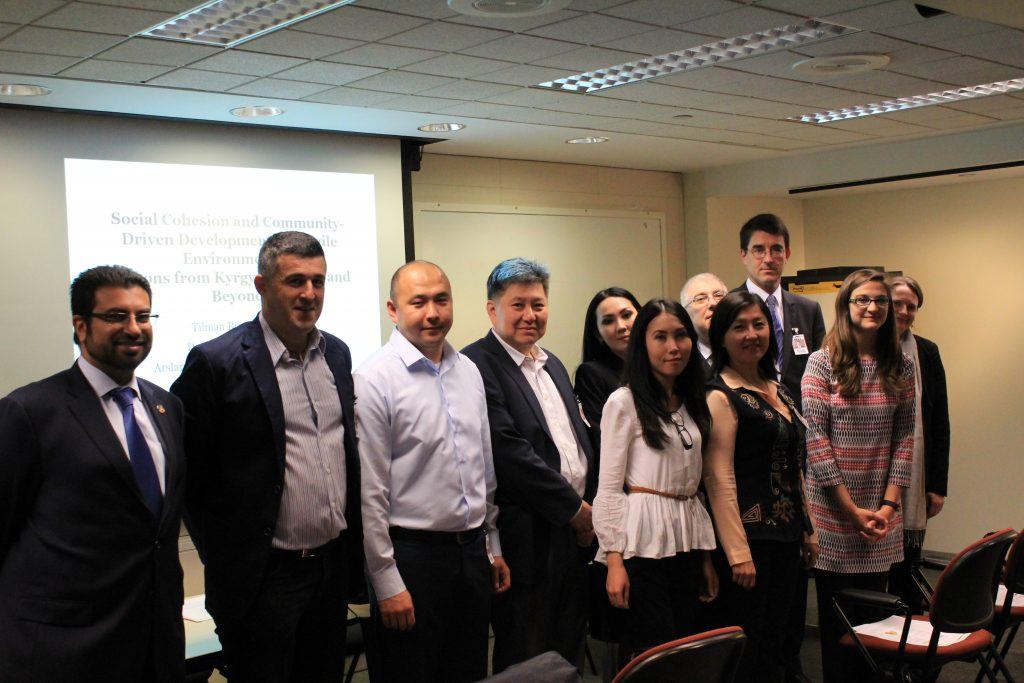Social cohesion — trust and cooperation in society — can be essential in tackling the underlying issues that can increase the risk of fragility and conflict. It has emerged over the last two decades as an important concept in both academic and political discourse, especially in fragile environments. At the same time, the evidence on how to build social cohesion and peace at various levels of society has been quite scarce.
On May 10, an event titled Social Cohesion in Fragile Environments, co-convened with the World Bank highlighted findings from the research and implementation components of the Social Cohesion through Community-Based Development program, a partnership between the World Bank and Aga Khan Development Network in the Kyrgyz Republic. The program focuses on research and finding new evidence on building peace and social cohesion at the micro-level. Damir Esenaliev, a member of the project research team with the Stockholm International Peace Research Institute that presented at the event, offers his reflections.

What if you could have a better tool to measure development outcomes of your program? And what if that tool could point out which components of your program are weak and which are strong? This seems to be the case with the community-driven development project in Kyrgyzstan. The program planners combined popular development interventions with robust research and design, designating metrics of social cohesion as an outcome. In Kyrgyzstan, social cohesion became a focus for development programs particularly following an episode of violent unrest in the southern city of Osh in 2010.
Several decades of investing hundreds of billions of dollars in community driven development (CDD) brought a sense of achieving local development and improved governance, but also implied a greater improvement in social cohesion. CDD has appeared to be a suitable approach to reach population in need directly and without burdening formal government institutions, especially in fragile and conflict-affected situations.
This was the idea behind the project on social cohesion through community driven development in Kyrgyzstan. The project had two important extensions beyond the standard CDD model. First, its research, conducted by SIPRI and the University of Central Asia, created granular metrics for measuring social cohesion based on one of the recent models in Europe, the Social Cohesion Radar developed by Jacobs University Bremen and Bertelsmann Foundation. Second, based on those metrics, the implementation team put additional efforts to target areas that showed weak social cohesion.
When we presented the project findings with our partners at the learning event at the World Bank, I felt it was a moment of truth. Would the experienced audience think such a metrics of social cohesion is expandable and applicable in other settings? Would they think there is more to be done to improve the effectiveness of the CDD approach in targeting more challenging development outcomes, such as social cohesion? The discussion that followed our presentations addressed many such issues and raised more. The concluding remarks made by the panel members pointed to three conclusions.
First, people generally believed that CDD enhances social cohesion, but the evidence so far is scarce. The attendees considered our project a good example of combining granular measurement of social cohesion as an outcome with the randomized impact evaluation method.
Second, an impact measurement tool that can be adopted in many CDD model settings exists with the Social Cohesion index developed for our project. The metrics are necessarily linked to the definition of social cohesion, which was in disarray for decades and can still be confusing. However, these suggested metrics require nuanced micro-level data to measure such a comprehensive, multidimensional concept of social cohesion.
Third, social cohesion is unique in time and space. Within the same country, you may find different views on what social cohesion is and how strong or weak it is. The society may have cultural preferences for one dimension or another of social cohesion’s aspects. Different social groups within the country may have different values and perceptions of social cohesion, including generational differences.
All in all, the project planners offered the CDD and social cohesion community an interesting case for measuring CDD’s most untraced outcome, social cohesion. This tool can be applied even in countries that had recent CDD interventions to see whether social cohesion is sustainable there. We have a good understanding of the prerequisites of a socially cohesive society, but this is an area where more research and practice are needed for better policies and interventions. The project partners would be happy to hear your views on this. You can contact us by email here.
Click here to view a recent Learning Note about the program.
Written by Damir Esenaliev, a Senior Researcher with the Stockholm International Peace Research Institute, an independent resource on global security. He is based in Stockholm with frequent visits to Kyrgyzstan.